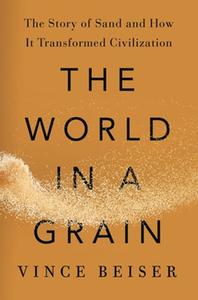
 Like Mark Kurlansky's single-focus books about cod and salt, investigative journalist Vince Beiser's first book is a rich study of one of the world's most abundant natural resources: sand. With a balance of statistics, science, history, on-the-scene reporting and some healthy environmental skepticism, The World in a Grain highlights the ways this ubiquitous global commodity has been essential to human development and advancement.
Like Mark Kurlansky's single-focus books about cod and salt, investigative journalist Vince Beiser's first book is a rich study of one of the world's most abundant natural resources: sand. With a balance of statistics, science, history, on-the-scene reporting and some healthy environmental skepticism, The World in a Grain highlights the ways this ubiquitous global commodity has been essential to human development and advancement.Sand is indispensable to global shelter, mobility and convenience. Mixed with cement it makes concrete. When near-pure sand is melted, it becomes glass. Special quartz sand is refined into flawless silicon to produce computer chips like those that established the eponymous California valley. Scarce round grain sand from Wisconsin and Minnesota provides the raw material for the high-pressure "fracking" of oil and gas wells. Major cities such as Dubai, Chicago, Lagos, Singapore and Hong Kong have created whole neighborhoods out of transported and dredged sand. And, of course, where would the snowbirds go if there weren't miles and miles of coastal sand beaches? No wonder Beiser calls sand "the literal foundation of modern civilization."
Chapter by chapter, Beiser investigates the role sand has played in world history. Without reinforced concrete, for example, the massive urban centers that hold most of the world's population wouldn't exist. As he emphasizes: "Concrete is an invention as transformative as fire or electricity.... Measured by the number of lives it touches, concrete is easily the most important man-made material ever invented." To put the rapid rise of urbanization in historical context, he points out that "China alone used more cement between 2011 and 2013 than the United States used in the entire twentieth century." That's a lot of sand and gravel aggregate to dig out of the earth. Besides buildings themselves, concrete and its stepchild, asphalt, also transformed the very heart of commercial transportation and personal mobility, moving the United States from 141 miles of paved roads in 1904 to today's 2.7 million miles supporting 256 million motor vehicles.
Each life-enhancing application of sand and its many manufactured manifestations, however, creates a drain on the supply of this seemingly most common of resources. With balanced reporting, Beiser also explores the environmental and social implications of sand mining, the interstate highway system, fracking and the overbuilding of shoreline towers and marinas. For example, he observes that flooding caused by Hurricane Harvey in Houston was exacerbated by so much impervious concrete preventing natural absorption of all the rain. Or in Jakarta, with its 28 million people, "the unfathomable weight of all that concrete is slowly squashing the ground beneath it." In lucid prose, The World in a Grain illustrates the many marvels sand has brought to the world--while at the same time cautioning that without prudent use, the environment and sand's economic availability are threatened. --Bruce Jacobs, founding partner, Watermark Books & Cafe, Wichita, Kan.
Shelf Talker: With a judicious mix of statistics, science and on-site reporting, journalist Beiser's first book explores the extraordinary role of sand in world development and some of the future risks.

